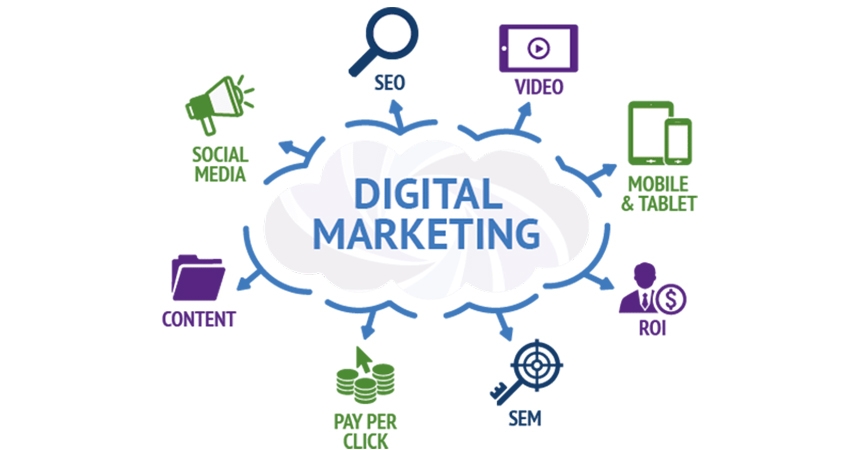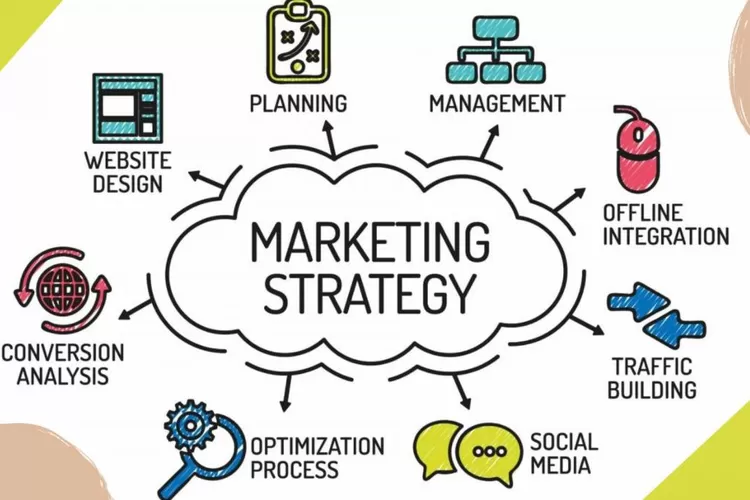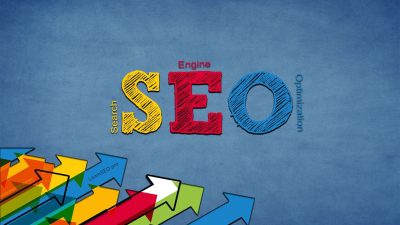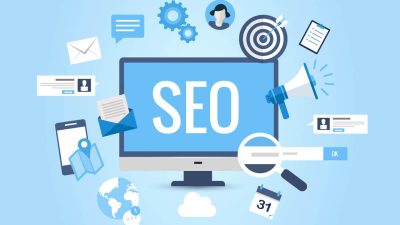In this digital era, businesses are constantly looking for innovative ways to connect with their target audience while also being mindful of the environment. This has led to the rise of eco-friendly marketing strategies that are not only effective but also sustainable. In this article, we will explore the concept of eco-friendly marketing and how it can help businesses unleash their digital domination.
In today’s fast-paced, interconnected world, businesses are constantly seeking innovative ways to reach and engage their target audiences. Digital marketing has emerged as a powerful tool to achieve these goals. In this comprehensive guide, we’ll explore the world of digital marketing, shedding light on what it is, why it’s essential, and how you can harness its potential.
Understanding Digital Marketing
Digital marketing encompasses a wide range of strategies and tactics used by businesses to promote their products, services, or brands through digital channels. It’s the art and science of leveraging the internet and electronic devices to connect with customers in meaningful ways. Digital marketing is more than just advertising; it’s about building relationships, creating value, and driving results.
Digital marketing is a broad term that encompasses all marketing efforts that use an electronic device or the internet. It involves promoting and advertising products, services, or brands through various online channels and platforms to connect with potential customers. Digital marketing leverages the power of the internet and digital technologies to reach a wide and targeted audience. Here are some key components and strategies within digital marketing:
- Search Engine Optimization (SEO)
SEO is the process of optimizing a website or online content to rank higher in search engine results pages (SERPs). The goal is to increase organic (non-paid) traffic to a website by improving its visibility when users search for relevant keywords. - Content Marketing
Content marketing involves creating and sharing valuable, relevant, and consistent content to attract and engage a target audience. Content can take various forms, including blog posts, videos, infographics, and more. - Social Media Marketing
This involves using social media platforms like Facebook, Twitter, Instagram, and LinkedIn to connect with the target audience, build brand awareness, and promote products or services. - Email Marketing
Email marketing involves sending targeted emails to a list of subscribers or potential customers. It’s used for various purposes, such as promoting products, sharing updates, and nurturing leads. - Pay-Per-Click (PPC) Advertising
PPC advertising is a paid advertising model where advertisers pay a fee each time their ad is clicked. Platforms like Google Ads and Facebook Ads allow businesses to create targeted ads that appear when specific keywords or demographics are matched. - Affiliate Marketing
In affiliate marketing, businesses partner with affiliates (individuals or other businesses) who promote their products or services in exchange for a commission on sales generated through their efforts. - Social Media Advertising
This involves creating and promoting ads specifically on social media platforms. It allows for precise targeting based on user demographics, interests, and behaviors. - Influencer Marketing
Businesses collaborate with influencers, individuals with a large and engaged following on social media or other digital platforms, to promote their products or services to a receptive audience. - Content Syndication
This strategy involves distributing your content to third-party websites, platforms, or networks to reach a broader audience and gain more exposure. - Analytics and Data Analysis
Digital marketing relies heavily on data analysis to measure the effectiveness of campaigns and make data-driven decisions. Tools like Google Analytics and various social media analytics platforms help track key performance metrics. - Mobile Marketing
With the increasing use of mobile devices, mobile marketing involves optimizing content and advertising for mobile users, as well as leveraging mobile-specific channels like SMS marketing and mobile apps. - Video Marketing
Creating and promoting video content on platforms like YouTube and TikTok is an essential part of many digital marketing strategies due to the popularity of video content.
Digital marketing is highly dynamic, and strategies can vary depending on the business’s goals, target audience, and industry. Successful digital marketing often involves a combination of these strategies and adapting to evolving digital trends and technologies.

Why Digital Marketing Matters
Digital marketing matters for several reasons, and its significance continues to grow in today’s business landscape. Here are some key reasons why digital marketing is crucial:
- Widespread Internet Usage
The internet has become an integral part of people’s lives worldwide. Consumers use the internet to search for information, make purchases, and engage with brands. Digital marketing allows businesses to meet their audience where they spend a significant amount of time. - Global Reach
Digital marketing provides businesses with the opportunity to reach a global audience. This level of reach was previously unimaginable with traditional marketing methods. It enables businesses to expand their customer base beyond geographic boundaries. - Targeted Marketing
Digital marketing allows for precise targeting. Advertisers can tailor their messages to specific demographics, interests, behaviors, and even location. This helps in reaching the right people with the right message at the right time, increasing the chances of conversion. - Cost-Effective
Compared to traditional marketing channels like print or television advertising, digital marketing is often more cost-effective. Businesses can set flexible budgets and adjust their spending based on the performance of their campaigns. - Measurable Results
Digital marketing offers robust analytics and tracking tools. Businesses can measure the effectiveness of their campaigns in real-time. This data-driven approach allows for quick adjustments to optimize strategies for better results. - Engagement and Interaction
Digital marketing encourages interaction and engagement between businesses and their customers. Social media, for instance, allows for direct communication, feedback, and building relationships with customers. - Content Distribution
Content marketing is a vital aspect of digital marketing. It enables businesses to create valuable and informative content that can attract and engage their target audience. This content can be distributed across various digital channels, increasing brand visibility and authority. - Competitive Advantage
Many businesses, including competitors, are actively using digital marketing. Failing to embrace digital marketing strategies can put a company at a competitive disadvantage. Staying current with digital marketing trends and techniques is essential to remain competitive in the digital age. - Adaptability
Digital marketing allows for quick adjustments and adaptability. If a particular strategy isn’t working as expected, businesses can pivot and try new approaches without significant financial repercussions. - 24/7 Availability
Unlike traditional business hours, digital marketing operates around the clock. Websites, social media profiles, and online advertising are always accessible, enabling customers to interact with businesses at any time. - Data Insights
The wealth of data collected through digital marketing efforts provides valuable insights into consumer behavior, preferences, and trends. This data can inform product development, marketing strategies, and overall business decision-making. - Brand Building
Digital marketing helps build brand awareness and loyalty. Consistent online presence and engagement with customers can strengthen a brand’s reputation and credibility.
In today’s digital age, where consumers are increasingly online and mobile-centric, digital marketing is not just an option; it’s a necessity for businesses of all sizes. It allows companies to connect with their target audience effectively, compete in the marketplace, and adapt to changing consumer behaviors and preferences.
Navigating the Digital Marketing Landscape
Navigating the digital marketing landscape can be both exciting and challenging due to its dynamic nature and the plethora of options available. Here are some steps to help you navigate the digital marketing landscape effectively:
- Set Clear Goals
Begin by defining your digital marketing objectives. What do you want to achieve? Common goals include increasing website traffic, generating leads, boosting sales, or improving brand awareness. Clear goals will guide your strategy. - Understand Your Target Audience
Identify your target audience’s demographics, interests, and online behaviors. The more you know about your audience, the better you can tailor your marketing efforts to reach them effectively. - Choose the Right Channels
Select the digital marketing channels that align with your goals and audience. Common channels include search engines (SEO and PPC), social media, email marketing, content marketing, and more. Each channel has its unique strengths and strategies. - Develop a Content Strategy
Content is at the heart of many digital marketing efforts. Create a content strategy that focuses on producing valuable, relevant, and engaging content for your target audience. This includes blog posts, videos, infographics, and more. - Optimize for Mobile
Ensure that your digital marketing efforts are mobile-friendly. With the increasing use of smartphones and tablets, mobile optimization is crucial for website design, email marketing, and advertising. - Invest in SEO
Search engine optimization (SEO) is essential for improving your website’s visibility in search engine results. Research keywords, optimize on-page elements, and build high-quality backlinks to improve your site’s ranking. - Leverage Social Media
Establish a strong presence on social media platforms that resonate with your audience. Create a content calendar, engage with your followers, and consider using paid social media advertising to extend your reach. - Email Marketing
Build and segment your email list to send targeted and relevant emails. Personalize your messages and use email automation to nurture leads and retain customers. - Paid Advertising (PPC)
If budget allows, consider pay-per-click advertising campaigns on platforms like Google Ads and social media. Create compelling ad copy, set a budget, and monitor your campaigns closely to optimize performance. - Analytics and Measurement
Implement tracking tools like Google Analytics to monitor the performance of your digital marketing efforts. Regularly review data to make data-driven decisions and adjust your strategies as needed. - Testing and Optimization
Continuously test different strategies, ad creatives, and content variations to find what works best. A/B testing can help you refine your campaigns over time. - Stay Informed
The digital marketing landscape is ever-evolving. Stay updated with industry trends, algorithm changes, and emerging technologies. Follow industry blogs, attend webinars, and consider joining relevant professional organizations. - Compliance and Data Protection
Be aware of privacy regulations like GDPR and CCPA if you collect customer data. Ensure your digital marketing practices comply with these regulations to protect both your customers and your business. - Budget Management
Carefully allocate your digital marketing budget based on the channels and strategies that deliver the best ROI. Monitor your spending and adjust as necessary to optimize your campaigns. - Seek Expertise if Needed
If digital marketing seems overwhelming, consider hiring experts or agencies with specialized knowledge in areas like SEO, PPC, or social media marketing to help you achieve your goals.
Navigating the digital marketing landscape requires a strategic approach, flexibility, and a commitment to ongoing learning and improvement. By staying informed, setting clear objectives, and adapting to changes, you can effectively utilize digital marketing to grow your business and connect with your target audience.

Content Marketing
Content marketing is a strategic marketing approach that involves creating and distributing valuable, relevant, and consistent content to attract and engage a target audience. The primary goal of content marketing is to build trust, establish authority, and nurture relationships with potential and existing customers. Rather than focusing on direct sales pitches, content marketing aims to provide information, education, entertainment, or inspiration that is beneficial to the audience.
Key components of content marketing include:
- Content Creation
This involves producing various types of content, such as blog posts, articles, videos, infographics, podcasts, ebooks, webinars, and more. The content should address the needs, questions, or interests of your target audience. - Audience Targeting
Content marketing begins with a deep understanding of your target audience. You need to identify their demographics, behaviors, preferences, pain points, and challenges to create content that resonates with them. - Distribution
Once content is created, it needs to be distributed through appropriate channels. This may include your website, social media platforms, email newsletters, and other online channels. Distribution strategies ensure that your content reaches your intended audience. - SEO (Search Engine Optimization)
Content should be optimized for search engines to improve its visibility in search engine results. This involves using relevant keywords, optimizing on-page elements, and building high-quality backlinks. - Engagement and Interactivity
Content marketing encourages engagement with the audience. This can be achieved through comments, social media shares, likes, and discussions. Interacting with your audience builds a sense of community and trust. - Consistency
Consistency is essential in content marketing. Regularly publishing high-quality content keeps your audience engaged and coming back for more. It also signals to search engines that your website is active and authoritative. - Measuring and Analytics
Content marketing efforts should be measured to determine their effectiveness. Using tools like Google Analytics or social media insights, you can track metrics such as website traffic, conversion rates, click-through rates, and more.
Benefits of content marketing include:
- Building Brand Awareness
Creating valuable content helps increase your brand’s visibility and recognition among your target audience. - Establishing Authority
Consistently producing high-quality content on relevant topics can position your brand or organization as an industry leader or expert. - Lead Generation
Content marketing can generate leads by attracting visitors to your website or landing pages and encouraging them to sign up for newsletters, download resources, or request more information. - Customer Education
Content marketing can educate your audience about your products, services, industry trends, and best practices, helping them make informed decisions. - Improved SEO
Regularly updated and optimized content can boost your website’s search engine rankings, leading to increased organic traffic. - Customer Loyalty
Providing valuable content that addresses the needs of your existing customers can help retain their loyalty and encourage repeat business.
Content marketing is a long-term strategy that requires dedication and patience. It’s about building relationships and providing value over time rather than pursuing quick sales. When executed effectively, content marketing can be a powerful tool for achieving your marketing and business goals.
Social Media Marketing
Social media marketing is a digital marketing strategy that involves using social media platforms and websites to promote products, services, or brands and engage with an audience. It leverages the power of social networking sites to connect with potential customers, build brand awareness, drive website traffic, and ultimately achieve marketing goals. Social media marketing encompasses a wide range of activities and tactics, including:
- Creating and Sharing Content
This involves developing and sharing various types of content such as text, images, videos, and infographics on social media platforms. The content should be tailored to the preferences and behaviors of the target audience. - Community Building
Social media platforms allow businesses to build communities and followers around their brand. This includes attracting and engaging with users who are interested in your products or services. - Advertising
Social media advertising involves paid campaigns on platforms like Facebook, Instagram, Twitter, LinkedIn, and others. These campaigns allow for precise targeting based on demographics, interests, behavior, and more. - Engagement
Responding to comments, messages, and mentions on social media is essential. Engaging with your audience helps build relationships and shows that you value their input and feedback. - Influencer Marketing
Collaborating with influencers—individuals with a significant and engaged social media following—to promote your products or services can be a part of social media marketing. Influencers can help you reach a broader audience authentically. - Monitoring and Analytics
Utilizing social media monitoring tools and analytics platforms to track the performance of your social media efforts. This includes measuring engagement metrics, reach, clicks, conversions, and more. - Content Calendar
Planning and scheduling your social media posts in advance using a content calendar to maintain a consistent posting schedule and align with marketing objectives and events. - Hashtag Usage
Incorporating relevant hashtags in your posts to increase discoverability and reach on platforms like Twitter and Instagram. - User-Generated Content (UGC)
Encouraging your audience to create and share content related to your brand or products can help build trust and authenticity. - Paid and Organic Strategies
Balancing organic (unpaid) social media efforts with paid advertising to maximize your reach and impact on social platforms.
Benefits of social media marketing include:
- Brand Awareness
Social media platforms provide an excellent way to introduce your brand to a broad audience and increase its recognition. - Audience Engagement
Interacting with your audience on social media can build stronger relationships, leading to increased customer loyalty and word-of-mouth marketing. - Lead Generation
Social media can be an effective channel for generating leads and directing potential customers to your website or landing pages. - Customer Support
Social media can also serve as a platform for customer support and addressing inquiries, issues, or concerns. - Market Insights
Monitoring social media conversations can provide valuable insights into customer preferences, trends, and sentiment related to your industry or brand.
Social media marketing strategies should be tailored to your business goals, target audience, and the specific platforms you use. It’s important to continually evaluate and adapt your strategies based on performance data and changing trends in the social media landscape.
Email Marketing
Email marketing is a digital marketing strategy that involves sending emails to a group of individuals or subscribers with the goal of promoting products, services, or building relationships. It is a direct communication channel between a business and its audience, often used for a variety of purposes, including:
- Promotional Emails
These emails are designed to promote products, services, or special offers to encourage recipients to make a purchase. Promotions can include discounts, sales, and limited-time offers. - Transactional Emails
Transactional emails are sent in response to specific customer actions, such as confirming a purchase, providing order updates, or resetting a password. While primarily informational, they can also include opportunities for upselling or cross-selling. - Newsletters
Newsletters are typically regular emails that provide subscribers with valuable content, updates, industry news, or educational information. They help maintain engagement and build brand loyalty. - Lead Nurturing
Email marketing is often used to nurture leads and guide potential customers through the sales funnel. Drip campaigns, for example, send a series of automated emails to educate and engage prospects gradually. - Customer Onboarding
After a customer makes a purchase or signs up for a service, onboarding emails can help new customers get started and become familiar with the product or service. - Abandoned Cart Recovery
When a customer adds items to their online shopping cart but doesn’t complete the purchase, abandoned cart emails can be sent to remind them and encourage them to finalize their order. - Event Promotion
Email is a common channel for promoting events such as webinars, conferences, workshops, or product launches.
Key components and best practices in email marketing include:
- Segmentation
Dividing your email list into segments based on factors like demographics, purchase history, or engagement level allows for more targeted and personalized email campaigns. - Personalization
Personalize email content by addressing recipients by their names and tailoring the content to their interests and behaviors. - Compelling Subject Lines
The subject line is critical as it determines whether recipients open the email. A clear, engaging, and relevant subject line can improve open rates. - Mobile Optimization
Since many people check their emails on mobile devices, ensure that your emails are mobile-friendly and responsive in design. - Clear Call-to-Action (CTA)
Emails should have a clear and actionable message, whether it’s to make a purchase, read an article, or sign up for an event. - A/B Testing
Experiment with different elements of your emails, such as subject lines, content, images, and CTAs, to determine what resonates best with your audience. - Analytics and Tracking
Use email marketing software to track key metrics like open rates, click-through rates, conversion rates, and unsubscribe rates to measure the effectiveness of your campaigns.
Email marketing remains a valuable and cost-effective channel for businesses to engage with their audience, nurture leads, drive sales, and build lasting customer relationships. When executed strategically and with respect to recipient preferences, email marketing can yield excellent results for businesses of all sizes.
Pay-Per-Click (PPC) Advertising
Pay-Per-Click (PPC) advertising is a digital advertising model in which advertisers pay a fee each time their ad is clicked by a user. It’s a way to buy visits to a website rather than earning those visits organically through methods like search engine optimization (SEO). PPC ads are typically displayed on search engines, websites, or social media platforms, and advertisers bid on specific keywords or audience characteristics to have their ads shown to a relevant audience.
Key components of PPC advertising include:
- Ad Auctions
PPC ads are typically placed in an auction system, where advertisers compete for ad placement. Search engines like Google and Bing use complex algorithms to determine which ads to display for a given search query or on websites and social media platforms. - Keywords
Advertisers choose relevant keywords or phrases that they want their ads to appear for. When users search for those keywords, the ad may be displayed. Keyword selection is a crucial aspect of PPC advertising. - Bid Amounts
Advertisers set bids, which represent the maximum amount they are willing to pay for a click on their ad. Bids, in combination with the quality of the ad and landing page, determine an ad’s position in the search results or on a web page. - Ad Creatives
PPC ads typically consist of a headline, a brief description, and a link to a landing page. Advertisers create compelling ad copy that encourages users to click on the ad. - Landing Pages
When users click on a PPC ad, they are directed to a specific landing page on the advertiser’s website. The landing page should be relevant to the ad’s content and offer a seamless user experience. - Quality Score
Search engines assign a quality score to each ad based on factors like click-through rate, ad relevance, and landing page quality. A higher quality score can lead to better ad positioning and potentially lower costs per click. - Budget
Advertisers set daily or monthly budgets to control their spending on PPC advertising campaigns. Once the budget is exhausted, ads may stop displaying until the budget is replenished or the campaign is adjusted. - Ad Extensions
Advertisers can enhance their ads with extensions, such as site links, callouts, phone numbers, and location information, to provide additional information to users.
Benefits of PPC advertising include:
- Immediate Results
PPC campaigns can generate traffic and leads quickly, making it an effective strategy for businesses looking for immediate results. - Precise Targeting
Advertisers can target specific keywords, locations, demographics, and even user behaviors, ensuring that their ads reach a highly relevant audience. - Measurable ROI
PPC advertising provides detailed performance metrics, allowing advertisers to track the ROI of their campaigns and make data-driven decisions. - Control Over Spending
Advertisers have full control over their budgets, bids, and ad schedules, allowing them to manage costs effectively. - Testing and Optimization
Advertisers can continuously test and optimize their campaigns to improve click-through rates and conversion rates.
PPC advertising is commonly used on platforms like Google Ads (formerly known as Google AdWords) for search advertising and on social media platforms like Facebook Ads and LinkedIn Ads for display advertising. Successful PPC campaigns require ongoing monitoring, adjustments, and optimization to maximize their effectiveness and efficiency.
Affiliate Marketing
Affiliate marketing is a performance-based digital marketing strategy in which businesses or advertisers reward affiliates (publishers or partners) for driving traffic to their website or generating sales or leads. It operates on a commission-based model, where affiliates earn a commission for each customer or action they refer to the advertiser’s website through their marketing efforts. This form of marketing is a win-win situation for both parties involved: advertisers benefit from increased exposure and sales, while affiliates earn a commission for their promotional efforts.
Key components of affiliate marketing include:
- Advertiser (Merchant)
The business or company that offers products or services and seeks to increase sales or generate leads through affiliate marketing. - Affiliate (Publisher or Partner)
Individuals, website owners, bloggers, or businesses that promote the advertiser’s products or services on their platforms. - Affiliate Network
In many cases, affiliate marketing is facilitated through affiliate networks, which act as intermediaries connecting advertisers and affiliates. These networks provide tracking, reporting, and payment services, making it easier for both parties to manage their affiliate relationships. - Affiliate Links
Affiliates use unique tracking links provided by the advertiser or affiliate network to promote products or services. These links allow the advertiser to attribute sales or leads generated by specific affiliates. - Commission Structure
Advertisers determine the commission structure for their affiliate program. Commissions can be based on a percentage of sales, a fixed amount per sale or lead, or a hybrid model. - Cookies and Tracking
Cookies or other tracking mechanisms are used to record when a user clicks an affiliate link and makes a purchase or performs the desired action on the advertiser’s website. This tracking ensures affiliates are credited for their referrals. - Promotional Strategies
Affiliates use various promotional strategies to drive traffic and conversions, including content marketing, email marketing, social media marketing, paid advertising, and more.
Benefits of affiliate marketing for advertisers include:
- Cost-Effective
Advertisers only pay commissions when desired actions (sales, leads) are achieved, reducing the risk of advertising spend without results. - Expanded Reach
Affiliate marketers can help advertisers reach new audiences or niche markets they may not have otherwise accessed. - Performance-Based
Advertisers can track the performance of their affiliate campaigns in real-time, allowing for optimization and budget control. - Brand Advocacy
Affiliates can serve as brand advocates, promoting products or services to their loyal and engaged audience.
Benefits of affiliate marketing for affiliates include:
- Passive Income
Affiliates can earn commissions while generating passive income by promoting products or services they believe in. - No Product Creation
Affiliates do not need to create their products or services, saving time and resources. - Flexibility
Affiliates have flexibility in choosing products or services to promote and can tailor their strategies to their audience.
Affiliate marketing is a mutually beneficial arrangement that has gained popularity in e-commerce and other industries. However, it requires careful planning, proper tracking, and compliance with regulations to ensure a successful and ethical partnership between advertisers and affiliates.

Influencer Marketing
Influencer marketing is a digital marketing strategy that involves collaborating with individuals or influencers who have a significant and engaged following on social media, blogs, YouTube, or other online platforms. The goal of influencer marketing is to leverage the influencer’s credibility, reach, and influence to promote products, services, or brands to their audience authentically and effectively.
Key components of influencer marketing include:
- Influencers
Influencers are individuals who have built a loyal and engaged following on a particular platform or niche. They can be categorized based on their follower count, niche expertise, or the type of content they create (e.g., fashion, travel, fitness, food, technology). - Collaborations
Brands collaborate with influencers to create and distribute content that promotes their products or services. This content can take various forms, including sponsored posts, product reviews, unboxing videos, tutorials, and more. - Authenticity
Successful influencer marketing campaigns prioritize authenticity. It’s essential that the influencer’s endorsement feels genuine and aligns with their personal brand. This authenticity helps build trust with their audience. - Compensation
Influencers are compensated for their work, typically through a combination of payment and/or free products or services. The compensation can vary widely based on factors like the influencer’s reach, niche, and engagement rates. - Disclosure
To maintain transparency and comply with advertising guidelines, influencers are often required to disclose their paid partnerships with brands, such as by using hashtags like #ad or #sponsored. - Campaign Objectives
Brands define specific objectives for their influencer marketing campaigns, whether it’s to increase brand awareness, drive website traffic, generate leads, boost sales, or achieve other marketing goals.
Benefits of influencer marketing include:
- Access to Targeted Audiences
Influencers have followers who are interested in their niche or industry, ensuring that the brand’s message reaches a relevant and engaged audience. - Trust and Credibility
Influencers have established trust and credibility with their followers, making their endorsements and recommendations more impactful than traditional advertising. - Content Creation
Influencers often create high-quality, engaging content, saving brands time and resources in content creation. - Increased Visibility
Influencers can expand a brand’s reach and visibility, particularly among demographics that might be challenging to reach through other channels. - Social Proof
Positive reviews and endorsements from influencers can serve as social proof, convincing potential customers to trust the brand and make a purchase.
Influencer marketing can be particularly effective in industries such as fashion, beauty, travel, lifestyle, and food, but it can be adapted to nearly any niche. Successful influencer marketing campaigns require careful planning, selecting the right influencers, setting clear expectations, and measuring the campaign’s performance against defined objectives. Additionally, it’s crucial to maintain ethical and transparent practices in influencer marketing, such as clearly disclosing paid partnerships to the audience.
Video Marketing
Video marketing is a digital marketing strategy that involves using video content to promote products, services, or brands and engage with an audience. It leverages the power of videos to convey messages, tell stories, and connect with viewers on various online platforms. Video marketing can encompass a wide range of video types, including promotional videos, tutorials, testimonials, vlogs, product demonstrations, and more. It’s a highly effective and engaging form of content marketing.
Key components and tactics of video marketing include:
- Video Content Creation
Creating high-quality and engaging video content is at the core of video marketing. This content can be created in-house or outsourced to professional videographers or video production companies. - Platform Selection
Choosing the right platforms for video distribution is essential. Popular platforms for video marketing include YouTube, Facebook, Instagram, Twitter, LinkedIn, TikTok, and websites. Each platform may have different video formats and audience demographics. - Target Audience
Identifying and understanding your target audience is crucial for creating video content that resonates with them. Tailor your video content to address their needs, interests, and pain points. - Video SEO
Just like text content, videos can benefit from search engine optimization (SEO). Optimize video titles, descriptions, tags, and metadata to improve visibility in search engine results and on video platforms like YouTube. - Engagement and Interaction
Encourage viewer engagement through comments, likes, shares, and subscriptions. Respond to comments and engage with your audience to build relationships and foster a sense of community. - Storytelling
Effective video marketing often involves storytelling. Craft narratives that connect with viewers emotionally and keep them engaged throughout the video. - Call-to-Action (CTA)
Include clear CTAs within your videos, prompting viewers to take desired actions, such as visiting a website, subscribing to a channel, or making a purchase. - Video Analytics
Use analytics tools to track video performance, including metrics like views, watch time, click-through rates, and audience retention. Analyze this data to improve future video content.
Benefits of video marketing include:
- Higher Engagement
Videos are inherently engaging and can capture viewers’ attention better than text or images. - Improved Conversions
Video content can lead to higher conversion rates, whether it’s driving website traffic, generating leads, or encouraging product purchases. - Enhanced Brand Awareness
Videos can help build brand recognition and awareness by showcasing your products, services, and values. - Visual Explanation
Complex topics or products can be explained more effectively through video, making it easier for viewers to understand. - Shareability
Entertaining or informative videos are more likely to be shared on social media, expanding your reach and visibility.
Video marketing is a versatile strategy that can be used across various industries and platforms. It allows businesses to connect with their audience on a more personal level, convey their message effectively, and drive desired actions. The growth of online video consumption has made video marketing a crucial component of many digital marketing strategies.
Conclusion
In the ever-evolving landscape of digital marketing, staying adaptable and innovative is key to success. Digital marketing isn’t just about promoting products; it’s about building connections, providing value, and creating meaningful experiences for your audience. By understanding the various facets of digital marketing and keeping pace with emerging trends, you can leverage its power to drive your business forward and connect with customers in a digital world that’s constantly on the move.







